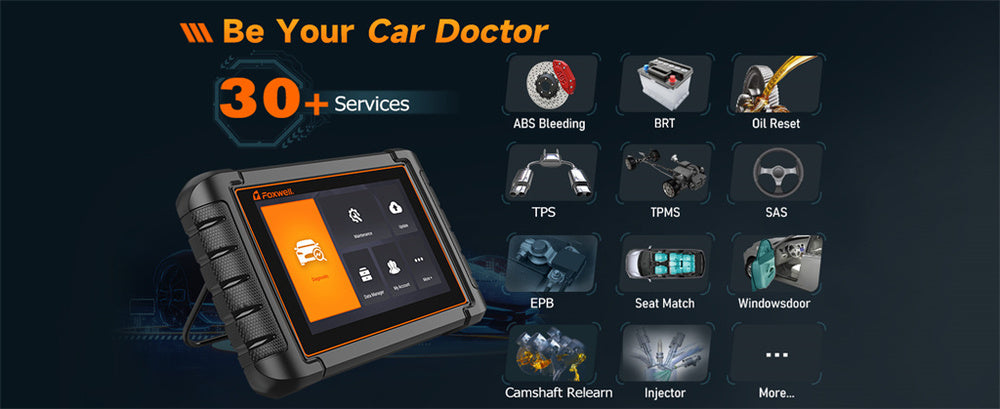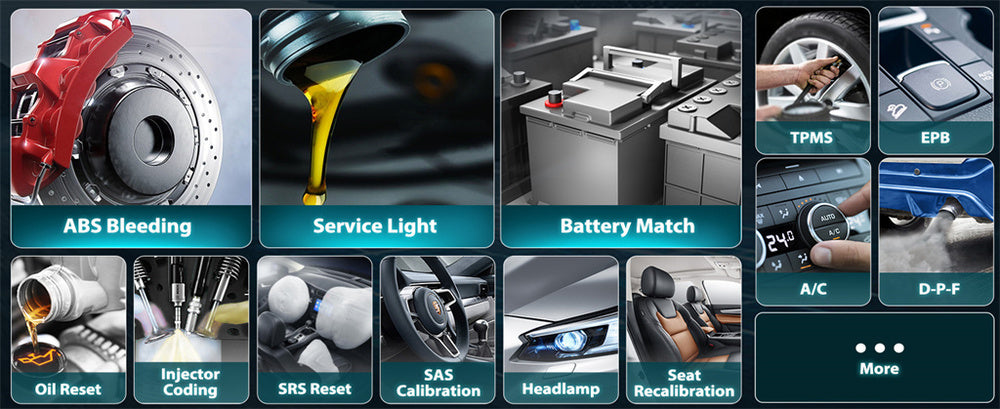Obd2 diagnostic scanner have become an indispensable tool for both professional mechanics and car owners in today's automotive world.
These handy devices help identify potential issues within vehicles to ensure timely maintenance and repairs are conducted promptly.
Gaining knowledge about their operation and benefits will save time, money, and stress in your daily commutes -There will examine these handy devices further by exploring their features such as benefits, types, and how best to utilize them effectively; plus, we'll introduce top products from various well-known brands.

What Is a Car Diagnostic Scanner?
A car diagnostic scanner is a device that reads and interprets error codes generated by a vehicle's onboard computer system, OBD codes, or Onboard Diagnostics codes.
These codes provide insight into various aspects of the vehicle's health, such as engine performance and emissions levels.
Definition and Purpose: A scanner connects to a vehicle's diagnostic port to retrieve data from its computer system, helping identify problems ranging from minor ones, such as loose gas caps, to major engine malfunctions.
Importance:Car owners can perform preliminary diagnostics before visiting a mechanic, saving both time on diagnosis and giving mechanics an immediate snapshot of potential issues.
How Does a Car Diagnostic Scanner Work?
Car diagnostic scanners connect to the OBD-II port of a vehicle's OBD. Once connected, they communicate with the computer system to retrieve diagnostic trouble codes.
Connection Process: Locate the OBD-II port near the steering column and plug your scanner in to connect with the vehicle's computer system.
Data Retrieval: Once connected, retrieve any relevant information about your car.
The scanner sends a request for data to the vehicle's onboard computer. In response, this provides specific codes that indicate various issues.
Code Interpretation:The scanner then displays these codes along with brief explanations of them.
Advanced models also provide detailed explanations and potential solutions.
Benefits of Utilizing a Car Diagnostic Scanner
Car owners using diagnostic scanners can gain several advantages, such as being alerted of potential issues before they escalate, which can potentially save thousands in costly repairs.
Cost Savings: Early detection can prevent costly repairs. By decreasing unnecessary mechanic visits, early diagnosis allows car owners to complete diagnostics themselves at home, saving both money and time.
Convenience: By being able to diagnose themselves at home, early diagnosis allows for cost-cutting solutions at any given moment.
It maintains immediate information regarding vehicle health, provides efficiency for mechanics by streamlining diagnostic processes in professional settings, and enables faster identification and resolution of issues.
Types of Car Diagnostic Scanners
Car diagnostic scanners come in various varieties, from primary code readers to more comprehensive diagnostic tools.
Each type offers its own set of features and depth levels of detail.
Basic Code Readers: Reasonably priced and user-friendly, basic code readers offer essential error codes and basic information.
When combined with advanced diagnostic tools, they offer more in-depth data collection and real-time monitoring capabilities.
Features include live data streaming, graphing, and detailed reports.
Mobile App-Based Scanners: By connecting via Bluetooth to smartphones or tablets, they offer portability and user-friendliness, along with user-friendly applications for user convenience.
Use of a Car Diagnostic Scanner
A car diagnostic scanner is an easy, straightforward way to identify issues with your vehicle quickly. Here's our step-by-step guide on how to use one effectively:
Locate OBD-II Port:
Locating the OBD-II Port:
The OBD-II port is often located near the steering wheel under the dashboard, covered with a protective cap that must be removed to access it.
Consult Your Manual: If you're having difficulty locating the port on your vehicle, consult its owner's manual for its precise location. Some models may feature it off-center or nearer the passenger side.
Proper Connection of Scanner: With caution, connect your diagnostic scanner to an OBD-II port using proper connectors. Check that everything is fully inserted and secure to avoid disconnections during scanning.
Power On: Most scanners will power on automatically after being connected. However, if yours has a power button, you must press it after plugging it in.
Turn On Your Ignition: Wrench off the ignition before starting your engine; this position enables your scanner to communicate with its computer system.
Electrical Systems Active: Verify that all of your car's electrical systems are active to indicate that it's in the appropriate mode for scanning.
Run a Scan:
Begin Your Scan:
Follow your scanner's instructions to start the scanning process. You can usually do this by browsing its menus and selecting either "Scan" or "Diagnostic."
Wait for the Scan to Complete: The scan should only take a few minutes to finish. During this time, it will collect data from your vehicle's computer, including diagnostic trouble codes.
Read the Codes:
Once a scan is complete, the scanner will display any stored error codes, usually consisting of letters and numbers (e.g., P0420).
Multiple Codes: If multiple issues exist simultaneously, multiple error codes may appear—note them all for future reference.
Interpret Code Definitions: Most scanners will briefly explain each code; for more detailed information, refer to your scanner's manual or an online database.
Researching Codes: Utilize websites or apps specializing in deciphering OBD-II error codes, as these resources can offer invaluable insight into each code's specific cause.
Address the Issues: For DIY repairs, evaluate whether the diagnostic results indicate whether you can resolve the problem without professional assistance. Minor issues like replacing sensors or tightening loose gas caps can often be handled using only essential tools.
Consult a Mechanic: Professional mechanics are recommended for complex issues or repairs you feel you need more confidence performing yourself. Please give them your diagnostic codes so they can quickly identify and fix the problem.
Post-Repair Scan: Once your vehicle's problems have been addressed, use a scanner to clear away error codes from its computer system and ensure they won't reappear unless there's still an issue present.
This ensures your efforts will yield lasting results, and nothing further arises that requires attention from you or authorities.
Monitor Performance: Drive the vehicle for several days after correcting an issue to ensure its effects have occurred; if codes reappear, further investigation may be required.
Regular Maintenance:
Periodic Scans: Use your scanner periodically, especially before long trips or unusual behaviors in your vehicle, to monitor any new codes or issues that arise.
Preventive Checks: Regular scans can detect potential problems early and prevent more severe issues later.
By following these detailed steps, a car diagnostic scanner can help maintain its health, reduce repair costs, and ensure timely fixes for any issues with your car. Understanding how these scanners work is an integral component of both DIY and professional mechanics' toolboxes—but no matter what your role is playing here!
Recommended Car Diagnostic Scanners
When selecting a car diagnostic scanner, many brands stand out for their reliability, features, and ease of use.
Here are a few top recommendations from well-known brands:
Foxwell NT301 OBD2 Scanner:
Features for reading and clearing engine fault codes.
Displays sensor data live as text or graph formats. Supports multiple languages.
Benefits:User-friendly interface with clear display; affordable price with comprehensive features; best for car owners and DIY enthusiasts.
Autel MaxiCOM MK808:
Comprehensive diagnostics for over 80 car makes and models—complete system diagnosis, including ABS, SRS, engine, transmission, and more. WiFi updates, as well as an Android-based tablet interface, provide convenient diagnostic services. Its advantages:
Advanced features with professional-level diagnostics in an easy-to-use tablet format. It is ideal for professional mechanics and advanced DIYers.
And now available with the CRP129E launch:
Features such as these:Diagnostic tool designed to examine vehicle engines, transmissions, ABS, and SRS systems. Live data graphing and recording. One-click updates via WiFi.
Advantages: Long list of systems covered. Intuitive touchscreen interface.
Best for: Car enthusiasts and mechanics.
BlueDriver Bluetooth Pro OBDII Scan Tool:
Features: (Bluetooth-enabled) It provides enhanced diagnostics and repair reports, including live and freeze frame data. Wedgeframe connectivity adds another level of diagnostic power.
Benefits: Portability/ease of use with mobile devices, Extensive database of fixes for error codes.

Conclusion
Car diagnostic scanners are essential tools for anyone owning or working on vehicles. They provide vital data that aid in keeping vehicles healthy while helping avoid significant issues down the line.
Investing in a quality diagnostic scanner can yield substantial financial and emotional returns, providing peace of mind knowing you can quickly and accurately diagnose issues as they arise.
No matter your car-owning or diagnostic needs, understanding and using car diagnostic scanners are an integral component. Foxwell, Autel, Launch, BlueDriver, and Innova all provide tools with specific features to meet different budgets, ensuring you can find one that best meets them.
FAQs
What is a car diagnostic scanner?
A car diagnostic scanner is a tool that reads and interprets error codes from a vehicle's onboard computer system.
How does a car diagnostic scanner work?
It connects to the car's OBD-II port and retrieves data about the vehicle's performance and issues.
Why should I use a car diagnostic scanner?
It helps identify and diagnose vehicle problems, saving time and money on repairs.




Leave a comment
This site is protected by hCaptcha and the hCaptcha Privacy Policy and Terms of Service apply.